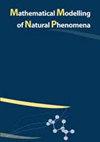具有通才捕食者的捕食-捕食模型的时空格局形成
IF 2.1
4区 数学
Q2 MATHEMATICAL & COMPUTATIONAL BIOLOGY
Mathematical Modelling of Natural Phenomena
Pub Date : 2021-07-03
DOI:10.22541/AU.162531612.21576519/V1
引用次数: 4
摘要
多面手捕食者利用多种食物来源,当特定猎物的密度水平相对较低时,对它们来说,减少对特定猎物的捕食压力是经济的。因此,当有多面手捕食者存在时,捕食者-猎物系统趋于稳定。本文研究了扩散和非局部猎物消耗在相互作用的多面手捕食者及其焦点被捕食者种群分布中的作用。在这方面,我们首先通过线性分析得出图灵不稳定性的相关条件。然后,我们进行了弱非线性分析,并在图灵分岔边界附近导出了一个三次Stuart-Landau方程,该方程控制了结果模式的振幅。此外,我们提出了各种各样的数值模拟来证实我们的分析结果,以及说明一些其他复杂的时空动态。有趣的是,我们的研究揭示了在时间双稳现象的影响下,图灵域中连接两个空间均匀共存稳态的行波解的存在性。此外,我们的研究表明,非本地猎物消耗是系统动力学的稳定力量。本文章由计算机程序翻译,如有差异,请以英文原文为准。
Spatiotemporal pattern formation in a prey-predator model with generalist predator
Generalist predators exploit multiple food sources and it is economical
for them to reduce predation pressure on a particular prey species when
their density level becomes comparatively less. As a result, a
prey-predator system tends to become more stable in the presence of a
generalist predator. In this article, we investigate the roles of both
the diffusion and nonlocal prey consumption in shaping the population
distributions for interacting generalist predator and its focal prey
species. In this regard, we first derive the conditions associated with
Turing instability through linear analysis. Then, we perform a weakly
nonlinear analysis and derive a cubic Stuart-Landau equation governing
amplitude of the resulting patterns near Turing bifurcation boundary.
Further, we present a wide variety of numerical simulations to
corroborate our analytical findings as well as to illustrate some other
complex spatiotemporal dynamics. Interestingly, our study reveals the
existence of traveling wave solutions connecting two spatially
homogeneous coexistence steady states in Turing domain under the
influence of temporal bistability phenomenon. Also, our investigation
shows that nonlocal prey consumption acts as a stabilizing force for the
system dynamics.
求助全文
通过发布文献求助,成功后即可免费获取论文全文。
去求助
来源期刊

Mathematical Modelling of Natural Phenomena
MATHEMATICAL & COMPUTATIONAL BIOLOGY-MATHEMATICS, INTERDISCIPLINARY APPLICATIONS
CiteScore
5.20
自引率
0.00%
发文量
46
审稿时长
6-12 weeks
期刊介绍:
The Mathematical Modelling of Natural Phenomena (MMNP) is an international research journal, which publishes top-level original and review papers, short communications and proceedings on mathematical modelling in biology, medicine, chemistry, physics, and other areas. The scope of the journal is devoted to mathematical modelling with sufficiently advanced model, and the works studying mainly the existence and stability of stationary points of ODE systems are not considered. The scope of the journal also includes applied mathematics and mathematical analysis in the context of its applications to the real world problems. The journal is essentially functioning on the basis of topical issues representing active areas of research. Each topical issue has its own editorial board. The authors are invited to submit papers to the announced issues or to suggest new issues.
Journal publishes research articles and reviews within the whole field of mathematical modelling, and it will continue to provide information on the latest trends and developments in this ever-expanding subject.
 求助内容:
求助内容: 应助结果提醒方式:
应助结果提醒方式:


